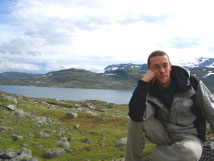 MSU Foundation Professor
MSU Foundation Professor
Depts of Plant Biology & Integrative Biology
Ph.D. University of Minnesota
W. K. Kellogg Biological Station
Michigan State University
Hickory Corners, MI 49060
Email: klausme1@msu.edu
Research Interests
Our laboratory group seeks to uncover the general principles that organize ecological communities and ecosystems. We focus on phytoplankton and zooplankton, the microscopic plants and animals at the base of lake and ocean food webs. Plankton communities are an ideal focus for this work, because they show striking patterns in space, time, and organization, and are easily manipulated in the lab and field. From a practical point of view, freshwater plankton are important determinants of water quality and marine phytoplankton play major roles in global biogeochemical cycles and perform about half the planet’s primary productivity.
We use a combination of theoretical and empirical approaches. Mathematical models provide a way to understand how species interactions determine community structure and affect the fluxes of energy and nutrients through the ecosystem. We study these models using the mathematical tools of nonlinear dynamics and with numerical simulation. Empirical approaches include the measurement of physiological parameters in laboratory cultures, population and community experiments in the laboratory, and the statistical analysis of lake survey datasets.
Recent and ongoing projects include: (1) developing and testing models of the vertical distribution of phytoplankton; (2) understanding the role of spatial heterogeneity on species competition and coexistence; (3) determining the causes of seasonal succession in plankton communities; (4) applying game theoretical approaches to models of community assembly; (5) explaining different sources of variation in the elemental stoichiometry of phytoplankton; and (6) exploring the dynamics of nonlinear food web modules.
Although we currently focus on plankton ecology, our interests are more diverse. Students in the group have worked on the evolution, maintenance and consequences of mutualism and the role of size in structuring ecological communities. Some of our past work includes modeling the origin of spatial patterns in semiarid vegetation and investigating the response of plant communities to habitat destruction. Therefore, we welcome inquiries from potential students interested in any area of theoretical or community ecology.
Selected Publications
- Litchman, E. and C. A. Klausmeier. 2008. Trait-based community ecology of phytoplankton. Annual Review of Ecology, Evolution, and Systematics 39: 615–639.
- Klausmeier, C. A., E. Litchman, T. Daufresne, and S. A. Levin. 2004. Optimal nitrogen-to-phosphorus stoichiometry of phytoplankton. Nature 429: 171–174.
- Klausmeier, C. A., E. Litchman, and S. A. Levin. 2004. Phytoplankton growth and stoichiometry under multiple nutrient limitation. Limnology and Oceanography 49: 1463–1470.
- Klausmeier, C. A., and E. Litchman. 2001. Algal games: the vertical distribution of phytoplankton in poorly-mixed water columns. Limnology and Oceanography 46: 1998–2007.
- Litchman, E., and C. A. Klausmeier. 2001. Competition of phytoplankton under fluctuating light. American Naturalist 157: 170–187.
- Klausmeier, C. A. 1999. Regular and irregular patterns in semiarid vegetation. Science 284: 1826–1828.

A legacy of conservation; a commitment to sustainability.
3700 E. Gull Lake Drive
Hickory Corners, MI 49060
(269) 671-5117
info@kbs.msu.edu